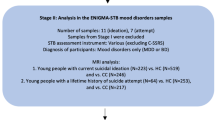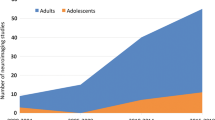Abstract
Our knowledge about the neurobiology of suicide is limited. It has been proposed that suicidal behavior generally requires biological abnormalities concomitant with the personality trait of impulsivity/aggression, besides an acute psychiatric illness or psychosocial stressor. We investigated fronto-limbic anatomical brain abnormalities in suicidal and non-suicidal adult female patients with unipolar depression. Our sample consisted of seven suicidal unipolar patients, 10 non-suicidal unipolar patients and 17 healthy female comparison subjects. The criterion for suicidality was one or more documented lifetime suicide attempts. A 1.5T GE Signa Imaging System running version Signa 5.4.3 software was used to acquire the magnetic resonance imaging images. All anatomical structures were measured blindly, with the subjects’ identities and group assignments masked. We used analysis of covariance with age and intracranial volume as covariates and the Tukey–Kramer procedure to compare suicidal patients, non-suicidal patients and healthy comparison subjects. Suicidal patients had smaller right and left orbitofrontal cortex gray matter volumes compared with healthy comparison subjects. Suicidal patients had larger right amygdala volumes than non-suicidal patients. Abnormalities in the orbitofrontal cortex and amygdala in suicidal patients may impair decision-making and predispose these patients to act more impulsively and to attempt suicide.
This is a preview of subscription content, access via your institution
Access options
Subscribe to this journal
Receive 12 print issues and online access
$259.00 per year
only $21.58 per issue
Buy this article
- Purchase on Springer Link
- Instant access to full article PDF
Prices may be subject to local taxes which are calculated during checkout


Similar content being viewed by others
References
Angst J, Angst F, Stassen HH . Suicide risk in patient with major depressive disorder. J Clin Psychiatry 1999; 60(suppl 2): 57–62.
Pokorny AD . Prediction of suicide in psychiatric patients: report of a prospective study. Arch Gen Psychiatry 1983; 40: 249–257.
Arango V, Underwood MD, Gubbi AV, Mann JJ . Localized alterations in pre- and postsynaptic serotonin binding sites in the ventrolateral prefrontal cortex of suicide victims. Brain Res 1995; 688: 121–133.
Mann JJ, Huang YY, Underwood MD, Kassir SA, Oppenheim S, Kelly TM et al. A serotonin transporter gene promoter polymorphism (5-HTTLPR) and prefrontal cortical binding in major depression and suicide. Arch Gen Psychiatry 2000; 57: 729–738.
Asberg M, Nordstrom P, Traksman-Bendz L . Cerebrospinal fluid studies in suicide. An overview. Ann NY Acad Sci 1986; 487: 243–255.
Mann JJ, Arango V . Integration of neurobiology and psychopathology in a unified model of suicidal behavior. J Clin Psychopharmacol 1992; 12: 2S–7S.
Apter A, Plutchik R, Van Praag H . Anxiety, impulsivity and depressed mood in relation to violent and suicidal behaviour. Acta Psychiatr Scand 1993; 87: 1–5.
Van Praag H . Serotonin-related, anxiety/agression driven, stressor-precipitated depression. A psychobiological hypothesis. Eur Psychiatry 1996; 11: 57–67.
Tebartz van Elst L, Woermann FG, Lemieux L, Trimble MR . Amygdala enlargement in dysthymia – a volumetric study of patients with temporal lobe epilepsy. Biol Psychiatry 1999; 46: 1614–1623.
Tebartz van Elst L, Woermann FG, Lemieux L, Trimble MR . Increased amygdala volumes in female and depressed humans. A quantitative magnetic resonance imaging study. Neurosci Lett 2000; 281: 103–106.
Tebartz van Elst L, Trimble MR, Ebert D . Dual brain pathology in patients with affective aggressive episodes. Arch Gen Psychiatry 2001; 58: 1187–1188.
Strakowski SM, Adler CM, DelBello MP . Volumetric MRI studies of mood disorders: do they distinguish unipolar and bipolar disorder? Bipolar Disord 2002; 4: 80–88.
Soares JC, Mann JJ . The anatomy of mood disorders – review of structural neuroimaging studies. Biol Psychiatry 1997; 41: 86–106.
Ongur D, Drevets WC, Price JL . Glial reduction in the subgenual prefrontal cortex in mood disorders. Proc Natl Acad Sci USA 1998; 95: 13290–13295.
Bowley MP, Drevets WC, Ongur D, Price JL . Low glial cell numbers in the amygdala in major depressive disorder. Biol Psychiatry 2002; 52: 404–412.
Ahearn EP, Jamison KR, Steffens DC, Cassidy F, Provenzale JM, Lehman A et al. MRI correlates of suicide attempt history in unipolar depression. Biol Psychiatry 2001; 50: 266–270.
Ehrlich S, Noam GG, Lyoo IK, Kwon BJ, Clark MA, Renshaw PF . White matter hyperintensities and their associations with suicidality in psychiatrically hospitalized children and adolescents. J Am Acad Child Adolesc Psychiatry 2004; 43: 770–776.
Spitzer RL, Williams JBW, Gibbon M, First MG . Structured Clinical Interview for DSM-III-R (SCID). American Psychiatric Press: Washington, DC, 2004.
Hamilton M . A rating scale for depression. J Neurol Neurosurg Psychiatry 1960; 23: 56–62.
Lacerda AL, Hardan AY, Yorbik O, Keshavan MS . Measurement of the orbitofrontal cortex: a validation study of a new method. Neuroimage 2003; 19: 665–673.
Caetano SC, Hatch JP, Brambilla P, Sassi RB, Nicoletti M, Mallinger AG et al. Anatomical MRI study of hippocampus and amygdala in patients with current and remitted major depression. Psychiatry Res 2004; 132: 141–147.
Kaur S, Sassi RB, Axelson D, Nicoletti M, Brambilla P, Monkul ES et al. Cingulate cortex anatomical abnormalities in children and adolescents with bipolar disorder. Am J Psychiatry 2005; 162: 1637–1643.
Brambilla P, Nicoletti MA, Harenski K, Sassi RB, Mallinger AG, Frank E et al. Anatomical MRI study of subgenual prefrontal cortex in bipolar and unipolar subjects. Neuropsychopharmacology 2002; 27: 792–799.
Brambilla P, Harenski K, Nicoletti M, Sassi RB, Mallinger AG, Frank E et al. MRI investigation of temporal lobe structures in bipolar patients. J Psychiatric Res 2003; 37: 287–295.
Lacerda AL, Nicoletti MA, Brambilla P, Sassi RB, Mallinger AG, Frank E et al. Anatomical MRI study of basal ganglia in major depressive disorder. Psychiatry Res 2003; 124: 129–140.
Caetano SC, Sassi R, Brambilla P, Harenski K, Nicoletti M, Mallinger AG et al. MRI study of thalamic volumes in bipolar and unipolar patients and healthy individuals. Psychiatry Res 2001; 108: 161–168.
Schoenbaum G, Chiba AA, Gallagher M . Orbitofrontal cortex and basolateral amygdala encode expected outcomes during learning. Nat Neurosci 1998; 1: 155–159.
Saddoris MP, Gallagher M, Schoenbaum G . Rapid associative encoding in basolateral amygdala depends on connections with orbitofrontal cortex. Neuron 2005; 46: 321–331.
Bremner JD, Vythilingam M, Vermetten E, Nazeer A, Adil J, Khan S et al. Reduced volume of orbitofrontal cortex in major depression. Biol Psychiatry 2002; 51: 273–279.
Lacerda AL, Keshavan MS, Hardan AY, Yorbik O, Brambilla P, Sassi RB et al. Anatomic evaluation of the orbitofrontal cortex in major depressive disorder. Biol Psychiatry 2004; 55: 353–358.
Pariante CM, Miller AH . Glucocorticoid receptors in major depression: relevance to pathophysiology and treatment. Biol Psychiatry 2001; 49: 391–404.
Rybakowski JK, Twardowska K . The dexamethasone/corticotropin-releasing hormone test in depression in bipolar and unipolar affective illness. J Psychiatr Res 1999; 33: 363–370.
Nemeroff CB . The corticotropin-releasing factor (CRF) hypothesis of depression: New findings and new directions. Mol Psychiatry 1996; 1: 336–342.
Oquendo MA, Placidi GP, Malone KM, Campbell C, Keilp J, Brodsky B et al. Positron emission tomography of regional brain metabolic responses to a serotonergic challenge and lethality of suicide attempts in major depression. Arch Gen Psychiatry 2003; 60: 14–22.
Jollant F, Bellivier F, Leboyer M, Astruc B, Torres S, Verdier R et al. Impaired decision making in suicide attempters. Am J Psychiatry 2005; 162: 304–310.
Bechara A, Tranel D, Damasio H, Damasio AR . Failure to respond autonomically to anticipated future outcomes following damage to prefrontal cortex. Cereb Cortex 1996; 6: 212–225.
Zermatten A, Van der Linden M, d'Acremont M, Jermann F, Bechara A . Impulsivity and decision making. J Nerv Ment Dis 2005; 193: 647–650.
Morgan MA, Romanski LM, LeDoux JE . Extinction of emotional learning: contribution of medial prefrontal cortex. Neurosc Lett 1993; 163: 109–113.
Morris JS, Öhman A, Dolan RJ . A subcortical pathway to the right amygdala mediating ‘unseen’ fear. Proc Natl Acad Sci USA 1999; 96: 1680–1685.
Altshuler LL, Bartzokis G, Grieder T, Curran J, Mintz J . Amygdala enlargement in bipolar disorder and hippocampal reduction in schizophrenia: an MRI study demonstrating neuroanatomic specificity. Arch Gen Psychiatry 1998; 55: 663–664.
Strakowski SM, DelBello MP, Sax KW, Zimmermann ME, Shear PK, Hawkins JM et al. Brain magnetic resonance imaging of structural abnormalities in bipolar disorder. Arch Gen Psychiatry 1999; 56: 254–260.
Frodl T, Meisenzahl EM, Zetzsche T, Born C, Jager M, Groll C et al. Larger amygdala volumes in first depressive episode as compared to recurrent major depression and healthy control subjects. Biol Psychiatry 2003; 53: 338–344.
Warner-Schmidt JL, Duman RS . Hippocampal neurogenesis: opposing effects of stress and antidepressant treatment. Hippocampus 2006; 16: 239–249.
Acknowledgements
This work was partly supported by American Foundation for Suicide Prevention, MH 01736, MH 30915, RR020571, NARSAD, the Krus Endowed Chair in Psychiatry (University of Texas Health Science Center at San Antonio), Veterans Administration (VA Merit Review), CAPES Foundation (Brazil), CNPq (Brazil). We thank Ellen Frank, PhD and David Kupfer, MD from Department of Psychiatry, Western Psychiatric Institute and Clinic, University of Pittsburgh Medical Center, PA, USA, for their invaluable help and support in patient recruitment.
Author information
Authors and Affiliations
Corresponding author
Additional information
Previous presentations: Society of Biological Psychiatry Annual Meeting, April 29th–May 1st, 2004, NY, USA and 18th ECNP Congress, October 22–26, 2005, Amsterdam, The Netherlands.
Rights and permissions
About this article
Cite this article
Monkul, E., Hatch, J., Nicoletti, M. et al. Fronto-limbic brain structures in suicidal and non-suicidal female patients with major depressive disorder. Mol Psychiatry 12, 360–366 (2007). https://doi.org/10.1038/sj.mp.4001919
Received:
Revised:
Accepted:
Published:
Issue Date:
DOI: https://doi.org/10.1038/sj.mp.4001919
Keywords
This article is cited by
-
Functional Abnormality of the Reward System in Depressed Adolescents and Young Adults with and without Suicidal Behavior
Brain Topography (2024)
-
Cognitive impairment and factors influencing depression in adolescents with suicidal and self-injury behaviors: a cross-sectional study
BMC Psychiatry (2023)
-
Machine learning based identification of structural brain alterations underlying suicide risk in adolescents
Discover Mental Health (2023)
-
History of suicide attempt associated with amygdala and hippocampus changes among individuals with schizophrenia
European Archives of Psychiatry and Clinical Neuroscience (2023)
-
Connectomics-based resting-state functional network alterations predict suicidality in major depressive disorder
Translational Psychiatry (2023)



